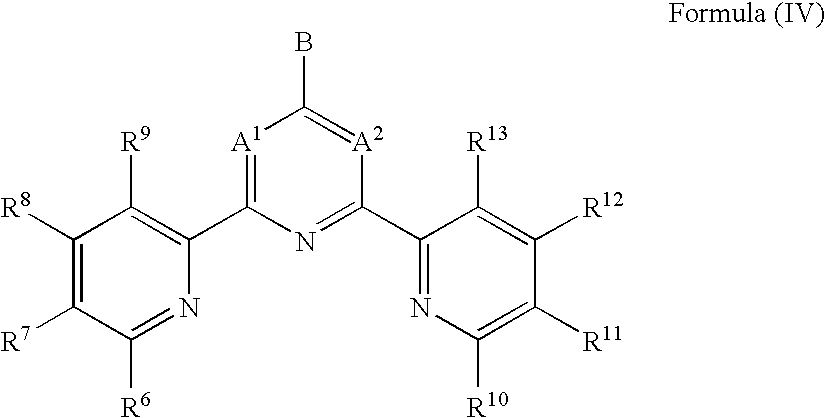Luminous Compound Containing Lanthanide Ion
a technology of lanthanide ions and luminous compounds, which is applied in the direction of luminescent compositions, organic compounds without c-metal linkages, group 3/13 organic compounds, etc., can solve the problems of affecting the use of color filters, affecting the effect of color filter excitation, so as to achieve the effect of convenient adjustment of excitation wavelength and convenient access
- Summary
- Abstract
- Description
- Claims
- Application Information
AI Technical Summary
Benefits of technology
Problems solved by technology
Method used
Image
Examples
example 1
Production of Ligand Part of Exemplified Compound (2)
[0068](1-1) Synthesis of 2-methyloxazolo[4,5-b]pyridine
[0069]80 mL of ethyl orthoacetate was added to 15 g (136 mmol) of 2-amino-3-hydroxypyridine, followed by addition of p-toluenesulfonic acid in a catalytic amount, and the mixture was reacted at 120° C. for 4 hours. After the reaction solution was cooled, triethylamine was added to the solution, to neutralize p-toluenesulfonic acid. Then, the solution was subjected to distillation under reduced pressure by using an evaporator, and then purified by silica gel column chromatography.
[0070]Amount of the product: 12.0 g, Yield: 65.8%.
(1-2) Synthesis of 2,4-dimethyloxazolo[4,5-b]pyridinium iodide
[0071]10 g (74.6 mmol) of the compound synthesized in the above (1-1) was suspended in 70 mL of acetone, followed by addition of 10 mL of methyl iodide, and the mixture was refluxed under heating for 5 hours. After the reaction solution was cooled, the precipitated crystals were collected by ...
example 2
Production of Exemplified Compound (4)
[0079](2-1) Synthesis of 2,3,3-trimethyl-3H-pyrrolo[2,3-b]pyridine
[0080]20 mL of 3-methyl-2-butanone was added to 10 g of 2-hydrazinopyridine, and the mixture was heated at 80° C. for one hour. The produced water and excess 3-methyl-2-butanone were removed by distillation under reduced pressure. Then, 1 g of zinc chloride was added to the residue, followed by heating at 200° C. for 3 hours. The resulting mixture was distilled under reduced pressure, and the residue was recrystallized from hexane, to obtain the target product.
[0081]Amount of the product: 4.6 g, Yield: 31.0%.
(2-2) Synthesis of 2,3,3,7-tetramethyl-3H-pyrrolo[2,3-b]pyridinium
[0082]4 g (25 mmol) of the compound obtained in the above (2-1) was dissolved in 40 ml of acetone, and 4 mL of methyl iodide was added thereto. The mixture was refluxed under heating for one hour. After the reaction solution was cooled, the precipitated crystals were collected by filtration, washed with acetone,...
example 3
Production of Ligand Part of Exemplified Compound (9)
[0093](3-1) Production of the Ligand Part of the Exemplified Compound (9)
[0094]2.56 g (10 mmol) of 2,3-dihydro-1H-benzo[d]pyrrolo[2,1-b]thiazolium bromide (synthesized with reference to the publication of JP-A-40-13759) and 1.9 g of cyanur chloride were suspended in 90 mL of dehydrated tetrahydrofuran, followed by slow, dropwise addition of 4 mL of N-ethyldiisopropylamine at room temperature. The mixture was reacted for 1 hour, and 30 mL of dimethylacetamide and 15 g of 3,5-dimethylpyrazole were then added to the reaction mixture. The mixture was subjected to distillation under reduced pressure, to remove tetrahydrofuran. The residue was heated at 80° C. for 2 hours, cooled, and then purified by silica gel column chromatography. Further, the obtained solid was dissolved in dimethylformamide, and ethyl acetate was added to the solid, to crystallize.
[0095]Amount of the product: 0.70 g, Yield: 15.8%.
[0096]Material Data
[0097]Mass spec...
PUM
| Property | Measurement | Unit |
|---|---|---|
| wavelengths | aaaaa | aaaaa |
| concentration | aaaaa | aaaaa |
| emission spectrum | aaaaa | aaaaa |
Abstract
Description
Claims
Application Information
 Login to View More
Login to View More - R&D
- Intellectual Property
- Life Sciences
- Materials
- Tech Scout
- Unparalleled Data Quality
- Higher Quality Content
- 60% Fewer Hallucinations
Browse by: Latest US Patents, China's latest patents, Technical Efficacy Thesaurus, Application Domain, Technology Topic, Popular Technical Reports.
© 2025 PatSnap. All rights reserved.Legal|Privacy policy|Modern Slavery Act Transparency Statement|Sitemap|About US| Contact US: help@patsnap.com



